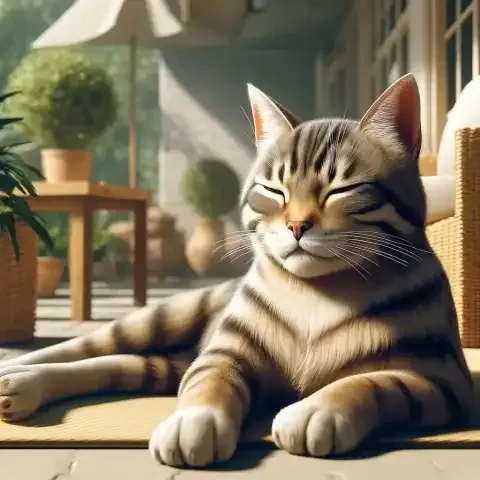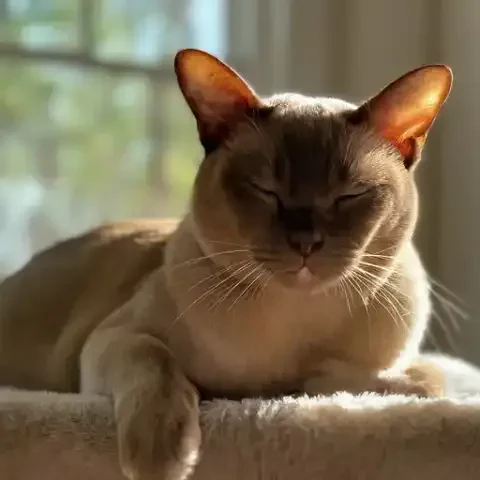Cats. They purr, they pounce, they intrigue – and they are often shrouded in myths. From aloof loners who only deign to share our homes for the convenience of a readily available food source, to midnight mischief-makers engaging in mysterious nocturnal rituals, popular culture and old wives' tales have painted a picture of cats that often strays far from the vibrant, complex, and truly wonderful reality. For creatures that share our homes and our lives, cats remain remarkably misunderstood.
These misconceptions about cats are surprisingly persistent. Perhaps it's their independent nature, so often misinterpreted as coldness. Maybe it’s because, for a long time, feline behavior and needs were less thoroughly researched and understood compared to their canine counterparts. Or perhaps, it’s simply a matter of ingrained cultural biases and outdated anecdotes passed down through generations. Whatever the reason, these myths about cats are not just harmlessly inaccurate; they can have a significant negative impact on cat welfare and the human-cat relationship. Misunderstandings fueled by these myths can lead to neglect, incorrect care practices, and unfair judgments about feline personalities and capabilities. When we approach cats based on false assumptions, we miss out on the chance to truly appreciate them for who they are and to build deeper, more rewarding bonds.
This article aims to unmask the feline mystique by systematically debunking some of the most common and pervasive myths surrounding cats. We will delve into the truth behind these misconceptions, revealing the real behaviors, needs, and multifaceted personalities of our feline companions. Our goal is to promote a more accurate and nuanced understanding of cats, fostering better care practices, stronger human-cat relationships, and a greater appreciation for these often-misunderstood animals. We will explore myths about their supposed aloofness, their activity patterns, their care requirements, their physical abilities, their relationship with water, their social nature, and even some specific myths surrounding milk, purring, and pregnancy. Prepare to have your feline preconceptions challenged and your understanding of cats transformed as we embark on a journey to uncover the truth behind the myths.
Let's start with one of the most damaging and widespread myths: that cats are aloof and unaffectionate creatures. This misconception paints cats as cold, independent beings who simply tolerate human presence for food and shelter, devoid of genuine emotional bonds or affection. It's a caricature that positions cats as starkly different from dogs, often portrayed as the epitome of loyal and loving companions. But is this portrayal accurate? Absolutely not. While cat affection may indeed be expressed in ways that differ from the often-exuberant displays of canine devotion, it is no less real, no less deep, and no less meaningful. To mistake the subtlety of feline affection for a lack of it is to fundamentally misunderstand the feline language of love.
Cats show affection in a myriad of ways, often nuanced and requiring a keen observer to fully appreciate. The gentle, rumbling purr, perhaps the most iconic feline sound, is frequently a clear sign of contentment and affection when directed towards their humans. The soft rub against your legs, weaving between your ankles, or the gentle head bunt against your hand or face – these are all tactile expressions of affection, marking you with their scent and seeking physical closeness. The slow blink, often referred to as a "cat kiss," is a subtle yet powerful signal of trust and relaxation in your presence. Kneading, that rhythmic pushing with their paws on soft surfaces, is a behavior rooted in kittenhood, associated with nursing and comfort, and often directed at beloved humans as a sign of contentment and affection. Many cats will follow their owners from room to room, simply wanting to be in their vicinity, a quiet testament to their bond. Vocalizations, beyond purring, can also be affectionate – soft meows, trills, and chirps are often directed at humans as forms of greeting or attention-seeking. And then there are the "gifts," those sometimes less-than-pleasant but nonetheless heartfelt offerings of prey – a mouse, a bird, a toy – brought to their humans as a sign of provision and affection, albeit in a way we might not always appreciate!
It's crucial to remember that, just like humans, cats are individuals with diverse personalities. Some cats are naturally more outwardly affectionate and demonstrative than others, just as some people are more effusive in their expressions of love. A quieter cat, who expresses affection through slow blinks and simply enjoying your presence in the same room, is no less attached or affectionate than a cat who constantly demands cuddles and vocalizes loudly for attention. Scientific studies are increasingly revealing the depth of the cat-human bond. Research has shown that cats form strong attachments to their owners, display separation anxiety when apart, and seek comfort from their humans in stressful situations, behaviors consistent with genuine emotional bonds. The truth is, cats are capable of deep and meaningful affection, expressed in their own unique feline ways. To truly understand and appreciate a cat is to learn to recognize and reciprocate their subtle yet profound language of love.
Another pervasive myth is that cats are nocturnal creatures, primarily active only during the night. This image of the shadowy, silent cat prowling under the moonlight is deeply ingrained in our cultural perception. However, while cats certainly can be active at night, labeling them strictly nocturnal is inaccurate. The reality is far more nuanced and connected to their evolutionary history. Cats are actually crepuscular, a term that describes animals that are most active during dawn and dusk. This activity pattern is directly linked to their natural hunting instincts. Dawn and dusk are the prime hunting times for many of their natural prey animals, such as rodents and birds, which tend to be most active during these twilight hours. Evolutionarily, it made perfect sense for cats to be most alert and active during these periods when hunting opportunities were highest.
While their crepuscular nature is biologically ingrained, cats are also remarkably adaptable creatures. Domestic cats, in particular, often adjust their activity patterns to coincide with the routines and schedules of their human families. Indoor cats, especially, are highly influenced by their environment. They quickly learn to adapt to household rhythms, often becoming more active during the day when their owners are home and available for interaction, play, and feeding. While they may still have bursts of energy at dawn and dusk, many indoor cats learn to sleep through the night alongside their human companions, becoming more diurnal, or day-active, to fit into the human household schedule. So, while cats retain their underlying crepuscular nature, their activity patterns are far from fixed and are significantly influenced by their environment and lifestyle. They are not strictly nocturnal, but rather adaptable twilight hunters who readily adjust to the rhythms of their human families and environments.
Moving on to another common misconception, many believe that cats are low-maintenance pets, requiring minimal care compared to, say, dogs. This myth often portrays cats as self-sufficient creatures who essentially take care of themselves, needing little more than food and a litter box. While cats are undeniably independent and self-reliant in many ways, the idea that they are "low-maintenance" is a significant oversimplification that can lead to neglect and a misunderstanding of their actual needs. The truth is, cats require consistent daily care, regular attention to their physical and mental health, and a lifelong commitment to providing a stimulating and enriching environment to truly thrive.
Daily cat care is far from minimal. It includes, of course, providing fresh food and water every day. But it also involves daily litter box cleaning, a task that is not only essential for hygiene but also for monitoring your cat's health – changes in urine or stool can be early indicators of medical issues. Furthermore, daily playtime and interaction are vital for a cat’s mental and emotional well-being. Cats need opportunities to play, to engage their hunting instincts, and to interact with their humans to prevent boredom, stress, and behavioral problems. Regular cat care extends beyond just daily routines. Grooming, including regular brushing and nail trims, is essential to prevent matting, hairballs, and overgrown claws. Dental care, often overlooked, is crucial for preventing dental disease, a common and painful condition in cats. Preventative healthcare, including regular veterinary checkups, vaccinations, and parasite control, is also a vital and ongoing part of responsible cat ownership. And, of course, veterinary care for illnesses and injuries throughout a cat’s life is an unavoidable and often significant aspect of cat ownership.
It's crucial to understand that cat care extends far beyond simply meeting their basic physical needs. Cats are sentient beings with complex mental and emotional lives. Their mental and emotional well-being is just as important as their physical health. They need environmental enrichment – opportunities to climb, scratch, explore, and engage their senses. They need social interaction, whether with humans or other feline companions (if properly introduced). They need a safe, stimulating, and predictable environment to feel secure and thrive. Neglecting these mental and emotional needs can lead to behavioral problems like anxiety, depression, destructive scratching, or aggression, as well as physical health issues stemming from stress. To truly care for a cat responsibly means committing to meeting their multifaceted needs – physical, mental, and emotional – throughout their entire life. "Low-maintenance" simply does not factor into the equation of responsible cat ownership.
Another widely circulated myth, often presented as a near-supernatural feline ability, is that cats always land on their feet. The image of a cat gracefully twisting in mid-air and landing flawlessly after a fall is a popular one, contributing to the perception of cats as inherently agile and indestructible. While cats are indeed remarkably agile and possess an impressive "righting reflex," the idea that they always land unscathed on their feet is a dangerous myth that can lead to complacency and potential harm. The truth is, cats can and do get injured from falls, and responsible owners should take precautions to prevent them.
The "righting reflex" is a real and fascinating feline adaptation. Cats possess a highly flexible spine, a keen sense of balance coordinated by their inner ear, and the ability to quickly rotate their bodies in mid-air. This reflex allows them to twist and orient themselves during a fall, increasing their chances of landing feet-first. They are indeed good at righting themselves, and often manage to land on their feet from considerable heights. However, this reflex is not foolproof, and it has its limitations. Falls from very low heights, surprisingly, can actually be more dangerous than falls from moderate heights. This is because from a low height, a cat may not have sufficient time to fully right themselves and orient for a safe landing, potentially resulting in injuries. Falls from greater heights, while seemingly more perilous, often give cats more time to fully execute their righting reflex and distribute the impact upon landing, though they still carry significant risks.
Even when a cat successfully lands on their feet, it doesn't guarantee they escape injury-free. The impact of landing, even when feet-first, can still cause significant trauma, especially from higher falls. Common injuries from falls, even seemingly successful landings, include broken bones (particularly legs and jaws), chest and abdominal injuries, and internal organ damage. "High-rise syndrome" is a recognized condition in veterinary medicine, describing the pattern of injuries seen in cats who have fallen from significant heights, often apartment buildings. These injuries are very real and can be serious, even fatal. Therefore, relying on the myth of cats always landing on their feet is a dangerous approach. Responsible cat owners should take proactive steps to cat-proof their homes, especially windows and balconies, to prevent falls in the first place. Window screens, secure balcony netting, and ensuring windows are properly closed or secured are essential safety measures to protect cats, regardless of their impressive righting reflex.
Another common feline myth, often based on anecdotal observation and perhaps a bit of anthropocentric thinking, is that cats universally hate water. The image of a struggling, hissing cat being forced into a bath is a familiar trope, seemingly solidifying the idea of inherent feline hydrophobia. However, the truth about cats and water is far more nuanced than this blanket statement suggests. While many domestic cats are indeed not naturally drawn to water, and some certainly dislike being wet, this aversion is not universal, and it's often learned or situation-dependent rather than an inherent feline trait.
It's important to note that aversion to water is not a universal feline characteristic across all breeds. Certain cat breeds, such as Maine Coons, Bengals, and Turkish Vans, are actually known to be more tolerant of, and sometimes even enjoy, water. Turkish Vans, in particular, are famously nicknamed the "swimming cat" due to their apparent fondness for swimming and playing in water. For most domestic cats, however, aversion to water is often rooted in a combination of factors. Sudden, forced immersion in water is generally a negative experience for any animal, and cats are no exception. A traumatic or unpleasant bathing experience early in life can certainly create a lasting aversion to water. The temperature of the water also plays a significant role. Cats, with their higher body temperature compared to humans, generally find cold water particularly unpleasant. Warm water is often tolerated much better, if bathing is necessary. The feeling of wet fur itself can also contribute to aversion. A cat's fur, when soaked, becomes heavy and can weigh them down, making them feel clumsy and uncomfortable.
It's also crucial to remember that cats are meticulous groomers. They spend a significant portion of their day keeping themselves clean through self-grooming. This natural grooming behavior often makes regular bathing unnecessary for most healthy, indoor cats. However, there are situations where bathing becomes necessary, such as for medical reasons (skin conditions, flea treatments) or when a cat becomes excessively dirty or contaminated with something unpleasant. When bathing a cat is required, doing it gently, calmly, and with positive reinforcement can significantly reduce stress and make the experience more tolerable. Using warm (not hot or cold) water, avoiding sudden immersion, using gentle cat-specific shampoos, and offering treats and praise can help make bath time less traumatic and even, in some cases, a somewhat positive experience. So, while many cats may not be naturally drawn to water, the myth that they all universally hate it and should never be bathed is simply untrue. Aversion to water is often learned or situational, and bathing is possible and sometimes necessary, especially when approached gently and positively.
Finally, let's address the myth of cats as inherently solitary creatures, preferring solitude and uninterested in companionship, particularly with other cats. This myth often portrays cats as fiercely independent animals who are best suited to living alone, perhaps tolerating human presence but certainly not enjoying feline company. While cats are indeed skilled solitary hunters, their social behavior is far more complex and adaptable than this myth suggests. The reality is that cats are facultatively social, meaning they are capable of being solitary hunters but are also able to form social groups and benefit from feline companionship, particularly in environments where resources are abundant and competition is low.
In natural settings, feral cats often form colonies, complex social structures centered around shared resources like food sources. These colonies are not just random gatherings; they often exhibit social hierarchies, cooperative behaviors, and even kinship bonds between related cats. Domestic cats, descended from these facultatively social ancestors, retain this capacity for social interaction. Many cats, especially when raised together from kittenhood or properly introduced as adults, can and do form strong bonds with other cats in the household. They may engage in mutual grooming, play together, sleep curled up with one another, and generally exhibit signs of feline companionship and social comfort. Feline companionship can be particularly beneficial for indoor cats, providing social interaction, play partners, and a reduction in boredom and loneliness when their human families are away.
However, it's also crucial to acknowledge that not all cats are inherently social, and not all cats will readily accept feline companionship. Individual cat personalities play a significant role. Some cats are naturally more independent and prefer to be only cats, while others are more social and thrive in multi-cat households. Successful integration of cats into a multi-cat household requires careful planning, gradual introductions, and proper resource management. Providing ample resources – multiple food bowls, water bowls, litter boxes, beds, scratching posts – spaced throughout the home, is crucial to minimize competition and territoriality in multi-cat environments. Understanding feline social dynamics and individual cat personalities is key to creating a harmonious multi-cat household. The myth of cats as inherently solitary creatures overlooks the reality that cats are adaptable social animals, capable of forming complex social structures and often benefiting from feline companionship, especially when introductions are handled thoughtfully and their environment supports multi-cat living.
Beyond these broad misconceptions, some more specific myths persist about cats, often related to their diet and health. One common example is the myth that cats can drink milk, and that it’s even a healthy and natural treat for them. The image of a cat lapping up a saucer of milk is a classic one, deeply ingrained in popular culture. However, the truth is that cow’s milk is not healthy for adult cats, and in fact, can cause digestive problems. Most adult cats are lactose intolerant. Like many mammals, cats produce the enzyme lactase, which breaks down lactose (the sugar in milk), most efficiently when they are kittens, allowing them to digest their mother’s milk. However, as they mature into adulthood, many cats lose much of their ability to produce lactase, leading to lactose intolerance. When lactose-intolerant cats consume cow’s milk, the undigested lactose ferments in their gut, leading to digestive upset, including diarrhea, gas, and stomach discomfort. While kittens can tolerate small amounts of milk, adult cats should generally avoid it. Water is always the best and most essential beverage for cats. If you wish to offer your cat a milky treat occasionally, lactose-free milk or specialized cat milk (formulated to be lactose-free and digestible for cats) can be given in very small amounts as an occasional treat, provided your cat tolerates it well. However, cow's milk is not a healthy or natural part of an adult cat's diet and should generally be avoided.
Another myth centers around purring, the iconic feline vocalization often associated with contentment. The common belief is that cats purr only when they are happy, relaxed, and feeling content. While purring certainly can be a sign of contentment and pleasure, the reality is that feline purring is far more complex and multifaceted, and doesn't always solely signify happiness. Cats do indeed purr when they are happy, relaxed, being petted, or enjoying a comfortable nap. However, research has revealed that cats also purr in a variety of other situations, including when they are stressed, injured, in pain, or even giving birth. Purring in these situations is believed to be a self-soothing mechanism, a way for cats to comfort and calm themselves when they are feeling anxious, stressed, or unwell. Some scientists also believe that the vibrations produced by purring may even have healing properties, promoting tissue regeneration and bone healing. The context and other body language cues are crucial for understanding the meaning of a cat's purr. A relaxed cat purring while being gently petted is likely expressing contentment. However, a cat purring while hunched over, hiding, or exhibiting other signs of distress may be purring as a self-soothing mechanism rather than an expression of happiness. Purring is a complex and fascinating feline vocalization that serves a variety of functions beyond simply indicating contentment.
Finally, one myth that often causes unnecessary anxiety, particularly for pregnant women, is the belief that pregnant women must get rid of their cats due to the risk of toxoplasmosis. Toxoplasmosis is a parasitic infection that can be harmful to a developing fetus if a pregnant woman contracts it for the first time during pregnancy. Cats can be carriers of the toxoplasmosis parasite, leading to concerns about cat ownership during pregnancy. However, the risk of contracting toxoplasmosis from cats is often overstated, and with simple hygiene precautions, pregnant women can safely live with cats. Toxoplasmosis is primarily transmitted through the ingestion of undercooked meat, contact with contaminated soil (such as in gardening), and, less commonly, through contact with cat feces. The risk of contracting toxoplasmosis from cats is relatively low, especially for indoor cats that do not hunt and are fed commercially prepared cat food. The most common routes of human infection are actually through consuming undercooked meat or gardening without gloves in contaminated soil, not directly from cats. Pregnant women can significantly reduce their risk of toxoplasmosis exposure by practicing simple hygiene precautions. These include having someone else clean the litter box daily, or wearing gloves and thoroughly washing hands after cleaning the litter box themselves. Avoiding undercooked meat, washing fruits and vegetables thoroughly, and wearing gloves while gardening are also important preventative measures, regardless of cat ownership. The vast majority of humans who contract toxoplasmosis do so from sources other than cats. With reasonable hygiene practices and awareness, pregnant women can safely and happily continue to live with their feline companions throughout their pregnancy. Consultation with a doctor is always recommended for pregnant women with specific concerns about toxoplasmosis, but in most cases, giving up a beloved cat is entirely unnecessary.
By shedding these outdated and inaccurate myths, we can begin to truly appreciate cats for the fascinating, complex, and wonderful creatures they are. Cats are not aloof robots, low-maintenance accessories, or creatures of nighttime mystery. They are intelligent, adaptable, capable of deep affection, and possess a wide range of personalities, just like any other species, including our own. By learning to understand their real behaviors, respecting their actual needs, and moving beyond these limiting myths, we can foster richer, more rewarding relationships with these often-misunderstood members of our families and the wider animal kingdom. Embracing the reality of cats, in all their complexity and individuality, is the key to unlocking a deeper appreciation for these truly remarkable companions.






